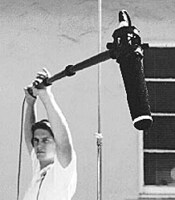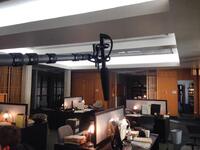 The following article was orginally written for Music Connection.
The following article was orginally written for Music Connection.
In the previous article, we stressed the need for proper monitoring of your audio and careful selection of your headphones. This month, we will look at the importance of proper microphone placement.
As musicians, you’ve had it relatively easy when it came to deploying your mics. Vocal microphones are kept close to the singer, often just inches away from the face. Instrument microphones are also at point blank range. These extremely close proximities are routinely practiced, even though the vocalist may be near screaming, and the volume of most raw instruments (or their amps) far exceeds that of the human voice.
(I know… Pure tracks, avoiding feedback, preventing audio bleed, and that sort of thing.) The point that I am making is that even with such high volume sources, audio engineers rely upon close-up miking to keep it all clean.
Yet when it comes to recording audio for video, it seems like the lessons learned in the recording studio are all but forgotten! The most common equipment set-up is a medium grade, electret condenser, short shotgun mic mounted directly atop the camcorder.
There are two major problems with that scenario.
To begin with, you are probably recording ordinary level conversation or interview, not loud instrumentals nor screaming solo-ists. Their sentences aren’t going to carry very far, and especially not if there is any background noise. You need microphones that are very directional and generally more sensitive than what you would need for music.
The second issue is that although light (as in picture) can travel seemingly without loss over great distances, sound waves dissipate quickly. Just because a common telephoto lens can zoom in on it and see it, does not mean that our microphone can isolate it and hear it.
Assuming that you are just shooting a simple interview in a moderately quiet room, it is unlikely that you would shove your lens only a foot or two away from the subject. Realistically, your camera would be seven to ten feet away in order to frame a comfortable medium shot or close-up.
That is where the problem lies. A shotgun mic, mounted on your camera, would also be seven to ten feet away! However, at that distance, your audio will be thin and heavily tainted by room noise and any background elements.
Shotgun microphones have very limited range compared to lenses. When I shoot feature films or commercials, I utilize the best full condenser microphones on the market. “Short” shotguns give me up to five or six feet overhead of my actors; and “long” shotguns can go up to eight or nine feet overhead, indoors comfortably (but they will exaggerate any acoustic echo). Those are full condenser microphones costing up to two grand!
Note that I keep using the word “overhead”. When a shotgun mic is pointed downward, the actor is directly on axis, where the mic is most sensitive. The long sides of the mic are way less sensitive, and do not pick up as much background noise coming from the sides of the set (towards the actor). But if you mount the microphone horizontally (atop the lens) as opposed to vertically (suspended from a boompole) — the background noise behind the actor tends to get sucked in and amplified. Much like the way a telephoto lens compresses perceived distance and brings background elements closer to the foreground.
So although a really good condenser shotgun mic could almost reach the seven to ten foot distance from camera to subject, all of the noise emanating from behind the subject would be added to their dialogue. That is also assuming that the shotgun microphone rejected all of the side noise; which it does not. Side rejection is not even close to absolute. Maybe a reduction of 35% or so. To make matters worse, sound waves rarely come from only one direction. They reflect off of nearly everything and bounce around the room, managing to pollute your desired audio coming from the subject’s direction.
Most videographers do not even utilize these expensive, full condenser short shotguns — such as the Sennheiser MKH60 and Audio Technica BP4073. Instead, they rely on medium grade, electret condenser shotguns such as the Sennheiser K3/ME66 or MKE600, Rode NTG-2, and Audio Technica AT897, to name a few. These microphones are all excellent microphones for their cost, and offer the advantage of being able to power from an internal AA battery or external Phantom. They are certainly superior to dynamic mics in terms of reach and directionality. I won’t even comment on the inexpensive, plastic, consumer “video shotgun” mics found on the amateur shelves — other than to say that I have tried them, and they impart a sour taste to cocktails when used as stirrers!
The reach of these (professional grade) electret condenser short shotguns varies, but average three to four feet overhead. Get beyond that three to four foot range, and the sound begins to get thin. You might still hear your subject up to several feet away under normal background conditions, but the dialog will sound more YouTube-ish and less primetime broadcast.
 The best results, especially with the less expensive prosumer/industrial shotgun mics, will be from suspending the mic pointed downwards, and from two to three feet overhead.
The best results, especially with the less expensive prosumer/industrial shotgun mics, will be from suspending the mic pointed downwards, and from two to three feet overhead.
You should bring at least a twenty-five foot long XLR mic cable, to allow for the ten foot camera distance, drop to the floor, and rise to the boom. A boompole and shockmount are important for serious production, but at the very least you could use a mic stand with boom arm to position the shotgun close to talent. Recruit a bystander to boom or even handhold the shotgun if you lack crew.
Although the best way to deploy shotgun mics is from above, they can also be pointed upwards from below. Note that positioning the mic from below may result in a slight increase of bass reflections from the ground, as well as from talent’s diaphragm. Easy enough to roll off the excess bass in post-production.
Speaking of bass, always engage the built-in bass roll-off on your shotgun mics when using them for dialog or field production. The only time to go “flat” is if you are recording music or sound effects and need that low punch. Otherwise, flat response on a shotgun just translates into hearing more handling noise, traffic noise, wind noise, and other low frequency background pollution.
Unlike dynamic mics, which need to be near chin height for most interviews, the electret condenser short shotguns function amazingly well at two to three feet, which is close to waist high. Feel free to use them as handheld “reporter” mics, but held just below frameline (and out of talent’s eye line, as well).
Never forget the “three foot rule” and your dialog will sound like a professional captured it. You are professional, aren’t you?
